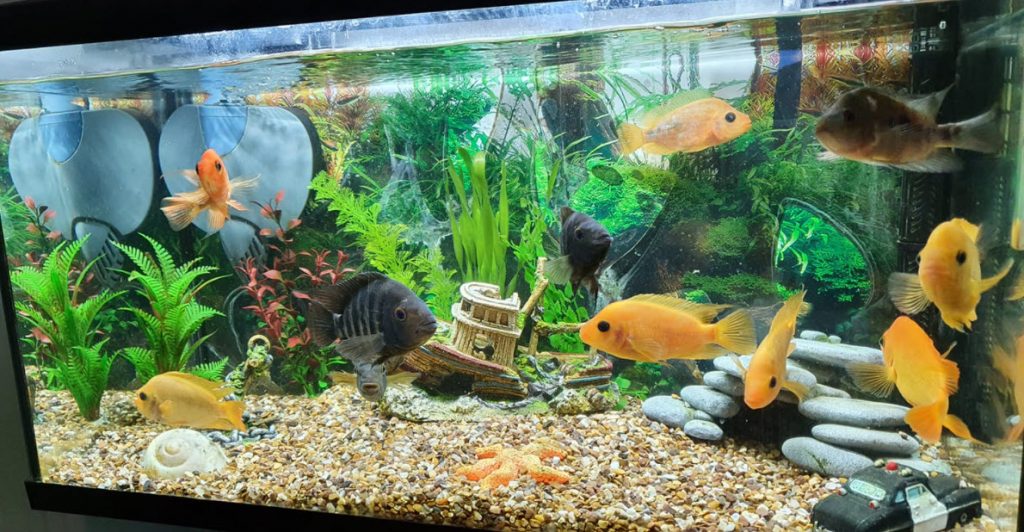
Many ascribe to the concept of “biotopes”, where fish and plants from a certain region are grouped together. These biotopes are:
- Central American
- Central American Lake
- Central American Stream
- South American
- South American Blackwater
- South American Clearwater
- South American Whitewater
- African
- Rift Lake Region
- Lake Malawi
- Rock Dwellers (mbuna)
- Free Swimmers (“Haps”)
- Sand Sifters (Peacocks)
- Lake Tanganyika
- Lake Victoria
- Lake Malawi
- West or Central African River
- Madagascar
- Rift Lake Region
- Australian
- New Guinea River
- Northern Australia Rainforest Creek
- Asian
- Indian/Burmese River
- Southeast Asian Blackwater Pool
- Southeast Asian Mangrove Estuary
- Southeast Asian River
There are many who try to set up aquariums per these biotopes. There are even competitions based on aquarium biotopes. Note that this can get very specialized. I’ve seen biotopes of only one particular stream in New Guinea for instance.
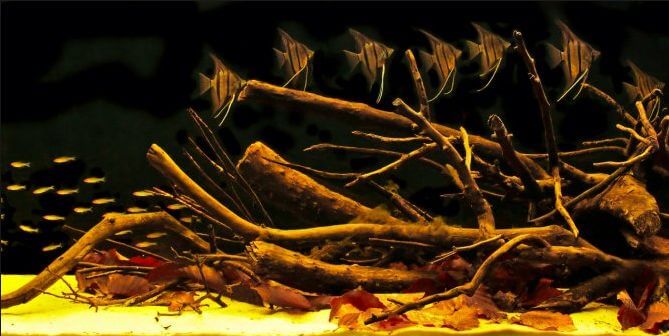
But most aquarium enthusiasts ignore the biotopes and just mix fish because they like them. This is perfectly acceptable. Will there be aggression issues? Of course, these are fish and will have aggression issues regardless of which biotope they are from. Will the fish be “stressed”? Sure, sometimes, but existence in the wild is a stressful thing for a fish. Will the life of the fish be shortened? There is no research or objective evidence of any correlation between life span and mixing biotopes.
Many will say that Central American cichlids can’t go with African cichlids as they will have “aggression issues”. Newsflash, ALL cichlid tanks have aggression issue from time to time. The aggression issues with cichlids cannot be predicted with any certainty. I’ve had normally peaceful yellow labs go on testosterone fueled “Pon Far” killing sprees and I’ve had an Oscar live for years with a goldfish that was supposed to be food.
Now if one mixes African cichlids with American cichlids one will probably be presented with some “challenges” as the fish mature. I find that if the American cichlids are larger than the African there are only the normal number of aggression issues. Of course with ANY cichlid “normal” is a large number. For instance I find convicts will beat up even larger Lake Malawi cichlids.
If the Africans grow to the same size or larger than the Americans the Americans typically (but not always) will suffer and will probably need to be segregated. But that is only a gross generalization. If one wants to mix them, I say go ahead with the full knowledge there will probably be challenges. It is your tank and if you want a challenge and a certain look, go for it.
Here is a tank with Central American Cichlids mixed with African Cichlids:
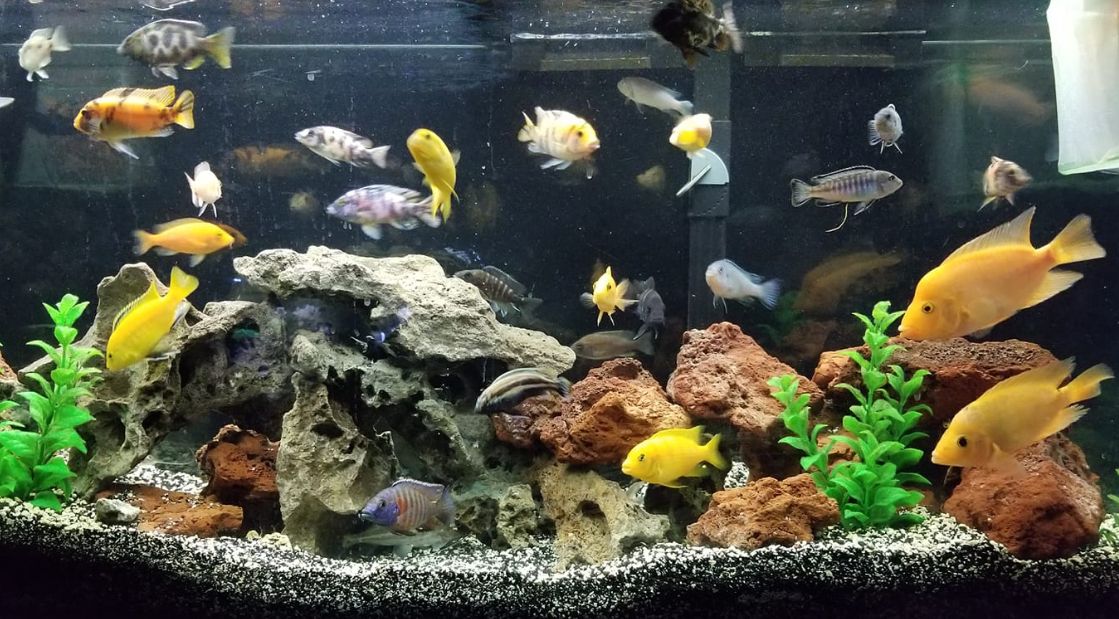
Note, like in all things, there are some social media “fish police” that attack anyone who mixes biotopes. One interesting lady said about mixing biotopes: “If we treated other animals this way with such blatant disregard to dietary needs and environmental conditions it would be considered animal abuse.” This is just a totally unjustified attack based on an imaginary standard that simply doesn’t exist. There is absolutely no evidence that mixing biotopes creates any inhumane dietary deficiencies or health problems in fish. NONE. Because one thinks there is a problem does not make it a fact.
I personally dislike the “fish police” who keep telling folks on social media what you can’t do with regards to aquariums. Each aquarium is a miniature natural ecosystem and Mother Nature is just very forgiving and VERY flexible. Literally every single “rule” I’ve seen in social media I have also seen violated quite successfully by many hobbyists. “You can’t mix African cichlids and American cichlids” is one such “rule” that is violated quite successfully very often.
Fish communicate their stress levels in many ways. They lose their color, they hide in corners with clamped fins, they don’t exhibit breeding behavior and they become thin and gaunt. There have been hundreds of videos and photos on Facebook of beautiful mixed biotope aquariums where all the fish had vibrant colors, were swimming vigorous and free, shimmying in breeding dances and were all fat.
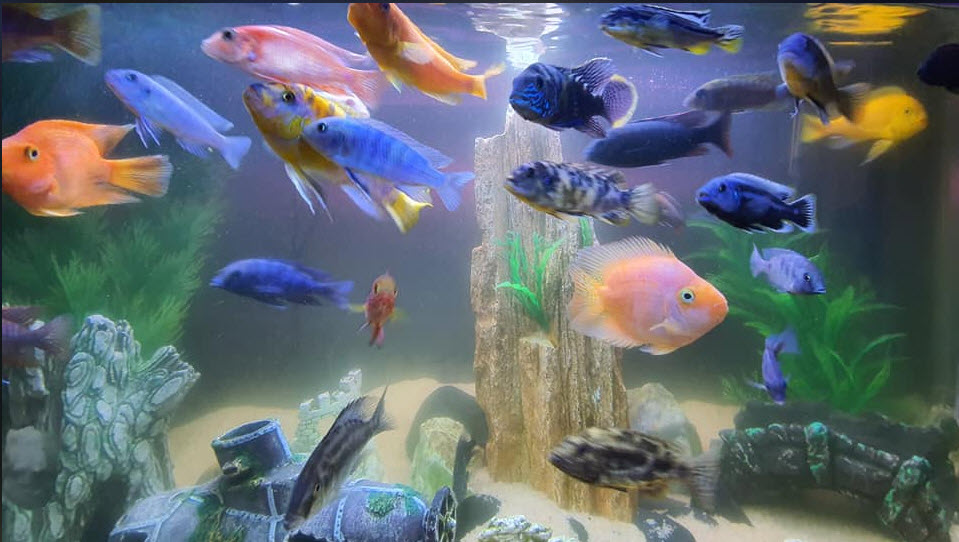
There is an outfit called Ohio Fish Rescue that does YouTube videos. They have many tanks filled with all sorts of fish in wild abandon. Africans, Central American cichlids, blackwater fish from the Amazon, Asian fish all mixed together. They have tanks with Oscars, a fish from soft water of South America, swimming side by side with large frontosas, a fish from the hard alkaline waters of Lake Tanganyika in Africa. You can’t get more different in “water requirements”.
There used to be a fish store in Venice Florida called “Father Fish”. He largely sold aquarium plants but had literally hundreds of aquariums filled with all sorts of freshwater fish in a mad jumble. For his freshwater he used reject water from his RO unit which he used to make his saltwater tanks up. Since he is in Venice his water was undoubtedly very hard and alkaline. And he was making it more hard by taking out RO water first. Yet he had all sorts of Amazon fish (lots of rams and appistos) in with all sorts of African fish and all sorts of Asian fish. He had very heavy stocking in all the tanks. His were some of the healthiest tanks I’ve ever seen. And he had been doing it this way for 20 years!
Mixed Cichlid Biotopes
Many think mixing fish from different native waters (so called “biotopes”) can’t be successfully done. The most common “rule” is that you can’t mix American and African cichlids. To illustrate how this isn’t true, here are three aquariums which violate this “rule” quite successfully:
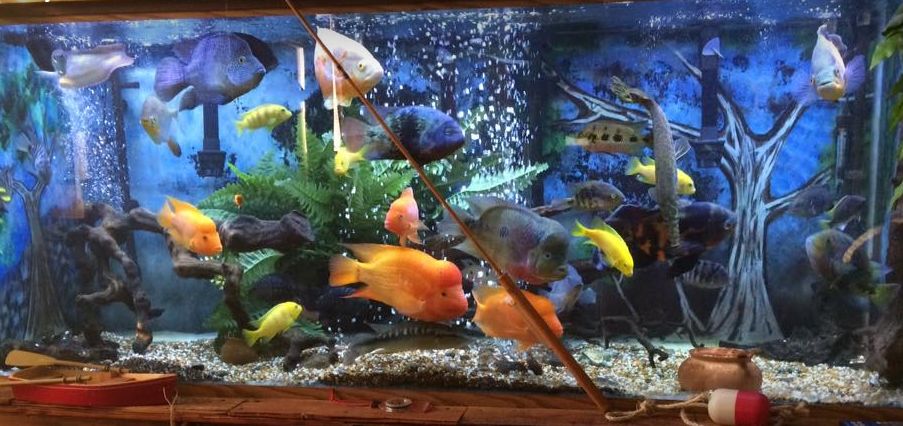
Another such aquarium
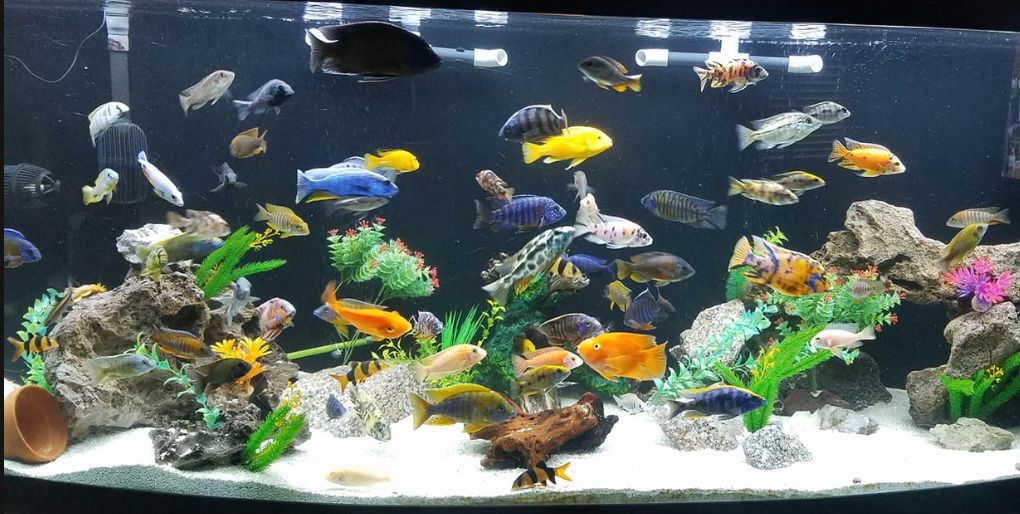
Still one more:
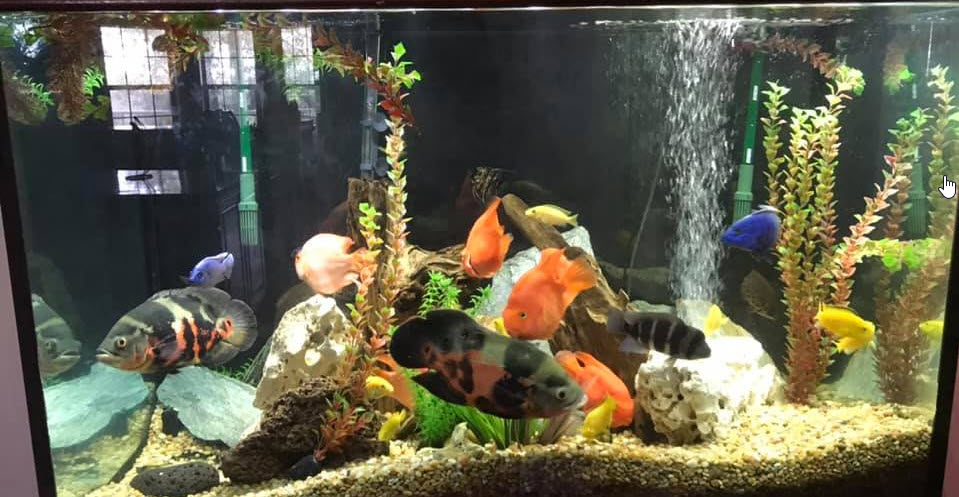
South American, Lake Malawi, Central American and Lake Tanganyika cichlids all living and thriving in the same aquarium and the same water chemistry.
When it comes to fish selection for the aquarium I like the Nike phrase “Just do it”. I’ve mixed biotopes and successfully “broken the rules” a huge number of times quite successfully many times in my fifty odd years in the hobby.
Size Matters
Much more important than biotopes is simply the size of the fish. One has to use some good old common sense here. Fish have very simple instinct based responses when it comes to other fish. Small fish get eaten by large fish in nature. So a small fish will normally be stressed out when it is put in an aquarium with a fish much bigger than it is.
If one puts a school of small harlequin rasboras in a tank with a bunch of large discus or angelfish the rasboras are quite naturally going to want to get well away from the discus or angelfish. If they cannot do that they are going to be very stressed and probably will have a host of health issues. So one should not mix the sizes of the fish in a tank too freely. I recommend never mixing fish if the smallest fish is less than half the length of the largest fish.
The Resistance
Now this article caused a bit of a stir when I wrote it. One website used one of the mixed biotope photos above and put a big red “X” over the photo.
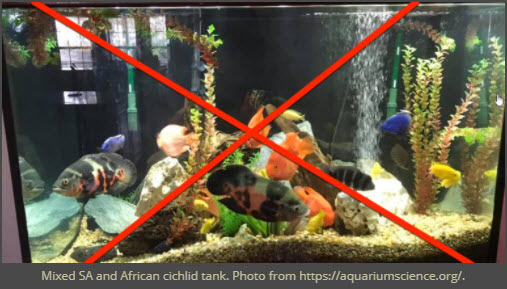
The author of this website ( https://thecichlidstage.com/mixing-new-and-old-world-cichlids/#more-6757 ) stated “The question here is ‘Can you mix cichlids from different continents?’ The short answer is ‘yes,’ but a better question is ‘Should you?‘ ”
He listed aggression, incompatible diets, and different water parameters as reasons not to mix biotopes. Aggression can be an issue with ANY cichlids. Diet and water parameters are simply NOT VERY IMPORTANT! We have covered aggression issues above and the diet and water issues are addressed in the links below.
Myths about Mixing Biotopes
Here are some common myths about mixing biotopes:
- The common myth that carnivores and herbivores need different foods is debunked in some depth in the section on foods. Here is a link to that:
3.1. Insignificance of the Type of Fish Food
- The common myth that one cannot mix fish from different pH waters and that pH is important to the health of the fish is debunked in some depth in the section on pH. Here is a link to that:
4.4.1. pH is not Important
- The common myth that one cannot mix fish from different GH waters and that GH is important to the health of the fish is debunked in some depth in the section on general hardness. Here is a link to that:
4.5.1. GH is not Important
- The common myth that one cannot mix fish from different KH waters and that KH is important to the health of the fish is debunked in some depth in the section on carbonate hardness. Here is a link to that:
4.5.2. KH is not Important
.
One particular type of biotope, the blackwater biotope, is discussed in this article:
17.2.1. Blackwater Biotopes.
.
Return to Fish Selection Menu
.
Aquarium Science Website
The chapters shown below or on the right side in maroon lead to close to 400 articles on all aspects of keeping a freshwater aquarium. These articles have NO links to profit making sites and are thus unbiased in their recommendations, unlike all the for-profit sites you will find with Google. Bookmark and browse!
.

Leave a Reply